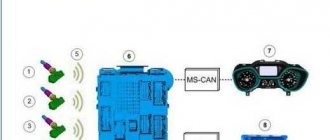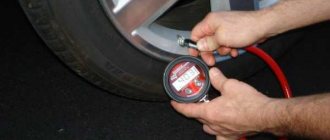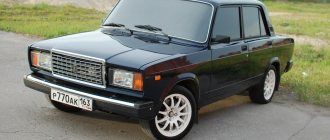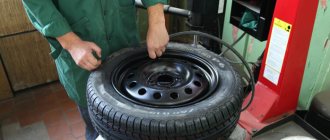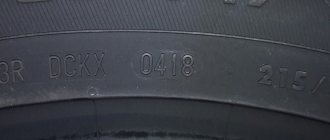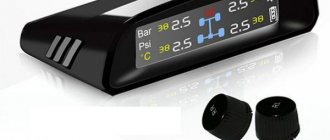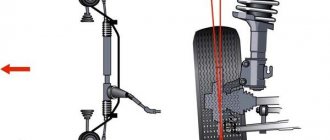| (Votes: 1, Rating: 5) |
Issues discussed in the material:
- Why measure car tire pressure
- What can result from improperly inflating car tires?
- Where to find information about optimal tire pressure
- How tire pressure reacts to temperature fluctuations in winter and summer
- Is it worth pumping nitrogen into tires?
If you have a car, you need to know what tire pressure should be. After all, when the wheels are properly inflated, driving a car will be comfortable and safe. Otherwise, an accident or serious damage may occur.
How to find out what tire pressure is
There are different units for measuring pressure. Previously, in Russia, car owners carried out measurements in technical atmospheres (kilogram-force per cm2).
On foreign cars, the European unit of measurement is used - bar. You can also find, especially in the United States, a non-systemic unit of measurement - PSI (pounds per inch2).
Today in our country, with the help of pressure gauges at car service centers, measurements are calculated in bars. The only negative is that this unit of measurement is not used in all countries.
If you need to convert PSI to bars, then the existing number must be divided by 14.5. An ultra-precise coefficient is not required, because any pressure gauge works with errors, so there is no point in trying to calculate the value extremely accurately.
Pressure gauges are divided into 3 types:
- switches;
- mechanical;
- electronic.
Today, the first type of pressure gauge is most often used. Its main advantages are reliability and low cost.
However, there is one drawback - the dial pressure gauge operates using a spring. If you drop it or hit it, the spring will fail, and it will be impossible to restore the mechanism.
No less effective is a mechanical pressure gauge, the operation of which is based on a cylindrical spring. But the error of such a device is great.
To take measurements with 100% accuracy, you should use an electronic pressure gauge. However, the device must be original, because fakes from China are often found.
Note! You can find out whether the tires are properly inflated when they cool down. To do this, the car must stand for at least 5 hours.
To find out what tire pressure is in the summer, the measurement must be carried out in the first half of the day before the car starts driving. Otherwise, friction will lead to overheating of the tires. As a result, the air in the tires will heat up, the pressure will increase, and the data obtained during measurements will be inaccurate.
If it’s winter outside, then when the car is parked for a long time, the wheels become lower. Therefore, control measurements are carried out at above-zero temperatures, for example in a garage. Or when you drive a little.
To check if your tires are properly inflated, follow these steps:
- Reset the pressure gauge readings.
- Unscrew the safety cap (if there is one) from the nipple.
- We connect the device to the nipple, lightly press on it, and the air will begin to escape from the tire.
- We are waiting for the pressure gauge needle to stop.
Remember that this measuring device operates with a small error of 0.2 kgf/cm2.
We recommend
“How to store tires without rims and where is the best place to do it” Read more
Why is it important to monitor your tire pressure?
The wheels must be properly inflated, because this affects the following parameters:
- rapid wear of rubber;
- braking distance;
- vehicle behavior in dynamics;
- fuel consumption.
This means that if a person has a car, he must know what pressure should be in the tires and adhere to this indicator so as not to cause harm to himself or other road users.
Road traction is possible thanks to tires. When the wheels are inflated correctly, the load distribution in the contact patch will be the same. The car consumes less fuel and the tread wears out evenly.
In what cases are the wheels incorrectly inflated:
- Insufficient pressure - tires are underinflated.
- Too much pressure - the wheels are overinflated.
- The tire pressure is not the same.
What could this lead to? The rubber quickly wears out, the car consumes more fuel, and the use of the vehicle becomes unsafe.
- Increased tire pressure
In this case, the contact patch will only be in the center of the tire. Over time, a tire will wear unevenly.If the pressure is increased, the braking distance will increase, because the contact patch with the road surface is too small.
The tires will also become inelastic. As a result, the wheels will not absorb impacts. And passengers in the cabin will feel every bump on the asphalt. Moreover, when you hit a hole or rock, your tires may become unusable.
The more the wheels are inflated, the stiffer they are. They move well over the surface, however, due to the fact that the contact patch is small, there is a risk of an accident. The car is moved on the road, the body and suspension experience increased loads. If a tire hits a pothole, it will break.
Are you transporting something heavy in your car or are all the passenger seats occupied? You should not overinflate your tires, as all of the above risks will only increase.
- Low tire pressure
When the tires are underinflated, the car consumes a lot of gasoline. Remember when you were riding a bicycle whose tires were under-inflated and you found it difficult to pedal.The same thing happens with a car: rolling resistance increases, the vehicle consumes a lot of fuel.
The service life of underinflated tires is sharply reduced. After all, the deformation area is too large, and the tread slips along the road surface. As a result, the rubber heats up and internal friction increases. When a car owner does not know what pressure should be in the car’s tires and the wheels are underinflated, many problems arise.
In addition, tires wear out quickly, because the contact patch is increased. A car with flat tires does not obey the driver and turns poorly.
The vehicle skids when you maneuver and the body angle changes.
Underinflated tires have a good effect on the chassis components, and the braking distance is also shortened. However, the car does not stand well on the road.
How can you tell if your tires are low? The tires will be deformed, the car reacts poorly to the driver’s actions, and is driven towards an underinflated wheel. There is a risk of the frame breaking, the cord threads may become unusable, and as a result such a tire will have to be thrown away, because the tire will be chewed up.
- Different tire pressures
Many novice car enthusiasts believe that it is not so important what pressure a car’s tires should have. Therefore, on their car, one wheel is underinflated, and the other is overinflated. But even someone who has been driving for a long time may have tires with different pressures. The reason is a tire puncture, different wear of the rubber.What could such carelessness lead to? If you brake sharply, the car will skid, because the contact area on all wheels is different. The car can even be completely turned around. It is obvious that driving such a vehicle is unsafe.
We recommend
“How to properly store and care for discs” Read more
How is the pressure in car tires checked?
The pressure is checked before the car is driven, which is called a “cold” tire. To measure the indicator, a tire pressure gauge is used, which can be purchased at any auto parts and auto accessories store. Devices are mechanical, pointer and electronic. They differ in the principle of operation and accuracy of readings. The choice of tire pressure gauge is determined by your preferences and financial capabilities. In addition, it is an integral part of a car compressor or tire inflation pump. This unit can also be used to check tire pressure.
If you find that the value in the wheels does not correspond to the recommended one, and neither a compressor nor a pump is at hand, you need to visit the nearest tire inflation point. Many gas stations are equipped with such posts. The service is provided free of charge.
Driving a car whose tire pressure is lower or higher than recommended can lead to unpleasant consequences.
If it is less than recommended, that is, the vehicle’s wheels are underinflated, then this is fraught with premature tire wear and increased fuel consumption. This occurs due to the constant deformation of the tire shape and, as a result, an increase in the rolling resistance force. In addition, the rubber heats up more. Underinflated tires do not wear evenly, but rather along the edges of the tread. But the worst thing is not the deterioration of the machine’s performance. With low tire pressure, vehicle controllability is reduced, directional stability is lost and there is a risk of the wheel “dismounting” while driving.
When operating a vehicle with increased (excessive) tire pressure, its handling also deteriorates due to reduced adhesion of the wheel to the road surface. In addition, the load on the suspension elements increases, which causes a decrease in its working life. Excessive pressure also causes the tire to deform and the middle part of the tread wears out.
Both in a situation with insufficient and in the case of increased tire pressure, driving a vehicle is not a pleasure - the car becomes harsh. Its further operation is associated with many problems that can be easily avoided.
The main thing is not to forget the basic rule:
Tire pressure adjustments should only be made before the vehicle starts moving (!). That is, the car must stand motionless for at least 2-3 hours. This is due to the fact that when driving the tires heat up, and this leads to an increase in pressure. All recommendations of the automaker are calculated exclusively for “cold” tires.
How often should you check your tire pressure?
Many car owners ask how often measurements should be taken?
Focus on the mileage of the car. Typically, blood pressure is monitored 2 times every 7 days. The fact is that the tire is not sealed, so it gradually deflates over time. If you have all-season tires, you will have to check whether the tires are sufficiently inflated more often. After all, as soon as it gets cold outside, the tires will become low.
When purchasing all-season tires, do not forget that in cold weather you will have to regularly inflate the tires. Of course, it is best to take measurements when you leave the parking lot, refuel your car, or arrive at a car service center. This must be done on each wheel, including the spare.
It also happens that in the luggage compartment there is not a standard wheel, but a so-called stowage wheel. The pressure in it should be lower than in other tires.
Is there no way to constantly monitor whether the tires are inflated? Then check if you have a long journey ahead.
When you visit a tire shop to change from winter to summer tires (and vice versa), ask the technician to properly inflate the tires.
Some car owners determine whether the tires are inflated by eye. It is not recommended to do this. After all, visually you will not be able to determine that the tires are underinflated (or overinflated) by 0.1–0.5 bar.
We recommend
“How to choose summer tires: nuances you should know about” Read more
How to measure car tire pressure
In order to measure what tire pressure your car has, there are several devices. These can be dial, mechanical or electronic pressure gauges. They have almost identical appearance, but different principles of operation.
Pointers are very accurate. But if you overload them, they immediately break. The fact is that under heavy loads the spring, the main component of the device, bends.
Mechanical pressure gauges are durable, but not accurate. But electronic ones are almost perfect at the moment. But they also have a drawback - high cost.
So, if you decide to find out what tire pressure your car has, remember that the tires must be cold. Otherwise, the readings will not be accurate. It is best to immediately increase winter pressure by 0.1 - 0.2 atmospheres. After all, sitting idle in a warm garage and driving on a snowy road are two different things. In summer, the value turns out to be accurate. Now we present to your attention a table of tire pressures by size.
How do manufacturers take care of car enthusiasts in this matter?
What pressure should the car tires have? You can find this out in the operating instructions for your car. However, for greater convenience, this data is located on the B pillar (driver's side) or on the gas filler flap.
Such a “cheat sheet” on the gas tank flap is rare.
And here is the “reminder” on the driver’s side door.
If the tire dimensions change, then they need to be inflated differently.
Since a vehicle may use tires of different types and sizes, the tire pressure will therefore vary. Moreover, it is allowed that the rear and front wheels are inflated equally or have different pressures.
However, most tires are inflated the same way. It is possible that the rear wheels are slightly underinflated. For example, what should the R17 tire pressure be if you have a Duster? All 4 wheels must have a pressure of 2 atmospheres. But for the Nissan X-Trail (crossover), we inflate the front tires to 2.3 bar, the rear tires to 2.1 bar.
Important! When the manufacturer cannot create an ideal ratio between the slip angles of the front and rear axles when turning, it is necessary to improve the performance by adjusting the pressure in the wheels. For example, on the Mazda CX-7 the rear axle slips, so the tire pressure must be higher.
What pressure should be in R16 tires, for example on a Lada Largus? The rear wheels are also pumped up by 0.2 bar, no matter how heavily loaded the car is. This is necessary to make it easier to operate the car.
We recommend
“How to change a rear wheel bearing: step-by-step instructions from an expert” Read more
Tire pressure table for the most popular cars
Each car model has its own optimal pressure indicator recommended by the manufacturer. Usually a special sticker with the necessary data is pasted on the body in a certain place. Most often it can be found on the driver's side front door or on the glove compartment lid. If the car owner has difficulty finding the sticker, the necessary information can be found in the instruction manual, which should be included when purchasing the car.
With the development of information technology, the necessary data has become available on the Internet; if necessary, a car owner can obtain information about the recommended tire pressure for his vehicle from the following tables:
What pressure should be in the tires and what influences the choice?
The wheels cannot have the same pressure all the time. After all, they are under the influence of unfavorable factors: frost, the transition from winter to spring, improper operation of the vehicle, and so on. However, it is necessary to monitor the pressure in the tires of a passenger car so that it does not become critically low or too high. How to determine the optimal indicator? Consider the vehicle parameters:
- what make and model of car;
- how much the car weighs - loaded and empty;
- what size are the wheels - R17, R18, etc.;
- under what conditions the car is used: what roads you drive on, in what season, and so on;
- drive aggressively or carefully;
- what time of year it is - in winter and summer, tires must be inflated differently, because in the hot season the rubber overheats, which means the pressure increases.
To make life easier for car owners who are wondering what pressure should be in the tires of a passenger car, manufacturers determine in advance how much certain wheels should be inflated. All you have to do is use this information when you go to the tire shop.
Of course, there is data from the manufacturer on how many bars should be in winter or summer tires. However, it is also recommended to clarify this information with a consultant when purchasing tires. The fact is that the pressure specified by the manufacturer is suitable for quiet movement on asphalt. But some car owners drive aggressively and the car drives off-road.
Use the following table “What pressure should be in passenger car tires” to choose the right tires:
| Under what conditions will the tires be used? | Adjustment | What does it mean |
| Long trips on smooth asphalt | The pressure should be 0.1–0.2 bar more than recommended. | The more the tires are inflated, the better the roll and the less the car will “eat”. |
| Driving on less-than-ideal asphalt surfaces, there are potholes and uneven surfaces. Driving on a dirt road. | There is no adjustment. | Inflate tires as recommended by the manufacturer. Then the car will stand well on the road, even during maneuvers. The impact on the body of shocks and impacts will be reduced. |
| Driving along a sandy, muddy road in icy conditions. | Tires should be underinflated by 0.1–0.2 bar. | Since the contact patch will be larger, the machine will not get stuck. |
Note! Weather conditions also affect tire pressure. We'll talk about this further.
We recommend
“Rear wheel wear: how to find the cause and protect the tires” Read more
Optimal tire pressure
Tire pressure is a value that depends on many factors:
- The model and, as a consequence, the carrying capacity and weight of the vehicle.
- Wheel diameter.
- Tire type.
- Season.
- Features of driving a car.
- Quality of the road surface.
Specific indicators will depend on the combination of all these factors, so the pressure in the tires of a passenger car is not a constant value. At the same time, car manufacturers indicate pressure standards for each car model in the operating manual.
Reference. Many car manufacturers place small decals in the driver's door area or on the inside of the gas filler flap. They provide figures for the recommended pressure in the rear and front wheels, based on the vehicle load. Recommendations for choosing pressure are also marked on the side surface of the tires.
For passenger cars, on average, the recommended pressure in the front wheels is 2.2 atmospheres, in the rear wheels - 2 atmospheres. But such parameters are not used in heavy cars and SUVs. Some manufacturers recommend increasing the pressure in the rear tires at maximum vehicle load to 0.8 atmospheres.
What pressure should tires have in winter?
No matter what season it is, the tires should be inflated equally. Don’t think that if you lower your tires, driving your car will be more comfortable.
When it gets cold outside, tire pressure decreases. This means that checks and swapping will have to be done regularly.
If you are going to perform this procedure in a heated garage (which is 5 degrees Celsius warmer than outside), then you need to inflate the tires 0.2 bar more. This trick will allow you to get perfectly inflated tires, even despite the temperature difference.
There is no need to delude yourself that if you overinflate your tires in winter, your car will be more stable. In reality it doesn't work like that.
Handling depends on the tread pattern, as well as the quality of the winter tires.
How to properly inflate tires in winter:
- You can check and inflate the wheels when the car has been outside for at least 120 minutes.
- Just left your heated garage? Consider the temperature difference between the garage and outside: for every 8–10 degrees Celsius, increase the pressure by 0.1 bar.
- Are the weather conditions relatively stable? Then the tire pressure should be as specified by the car manufacturer.
Note!
Even if you bought a car just recently, use a pressure gauge regularly, at least once every 30 days. Be sure to measure your blood pressure before you go on a trip. In the off-season, when the temperature regime is not stable, it is recommended to check every 14 days.
On the side of each winter tire you can find the minimum and maximum possible pressure. Winter wheels are softer than summer wheels. To make the car handle better, it is worth pumping up the tires more. Especially if it’s minus 30 degrees Celsius outside, because then the pressure in the tires decreases. But here it is important to know when to stop, otherwise you can only make things worse. If a sudden frost occurs, you should check whether the tires are properly inflated and inflate them. This is the only way to prevent unpleasant situations on the road.
We recommend
“The wheel hits when braking: ignore it or run to the service center” Read more
Tire pressure in winter and summer (table)
The data presented in the table is intended for vehicles stored in a warm box. As you can see, the difference between “summer” and “winter” pressure is about 0.1-0.2 atmospheres, and it is this that is designed to compensate for the difference in thermal expansion and contraction of air in the tire.
Despite the fact that we gave this example for popular VAZ models, a similar approach can easily be used for cars from other manufacturers.
You can also download a table of tire pressures for cars of different brands - HERE (word file).
How to properly inflate tires in summer
Remember that when the temperature outside changes, you change your driving style (calm-aggressive, fast-slow), the pressure in your tires will change.
For example, did it get 10° colder outside? This means that the tires will be lowered (by 0.1 bar). And if it’s plus 25 degrees Celsius outside, the pressure will increase (by 0.8 bar).
Without taking this fact into account, you will overinflate your tires while in an underground parking lot, where it is quite cold. As soon as the car enters the hot road surface, the pressure will become too high.
In summer, when the asphalt heats up to 40–50 degrees Celsius, road grip improves and friction increases. As a result, the temperature and pressure in tires become maximum. The tire may explode and an accident may occur. What pressure should be in summer tires:
- When it gets hot outside, tire pressure increases by 10–15%. Therefore, let the tires be underinflated by the same 10–15 percent.
- When checking, remember that the temperature inside and outside the tires should equalize, so it is better to use the pressure gauge in the morning.
- It is best to find out the permissible pressure values for front and rear tires in summer and winter in the operating instructions. Differences may be 0.1–0.2 bar.
We recommend
“What do the letters on car tires mean: decoding of all indices” Read more
What if you inflate your tires with nitrogen...
Modern tire shops offer an expensive procedure during which nitrogen is pumped into the tires. Why do many car owners choose this particular method of inflating wheels:
- Nitrogen maintains optimal pressure even when tires become hot.
- Rubber lasts longer and does not wear out, because nitrogen is cleaner than air.
- There is no corrosion on steel rims.
- It will not tear the rubber, because nitrogen is a non-flammable substance.
Unfortunately, all this is just a marketing ploy to attract consumers. The fact is that the nitrogen content in the air is 80%. Nothing will happen if you increase the content of this gas in the wheels by 10–15%.
Therefore, there is no need to spend money to pump nitrogen into your tires, because this procedure has no real advantages.
We recommend
“Polishing car wheels: what is it for and how to do it correctly” Read more
